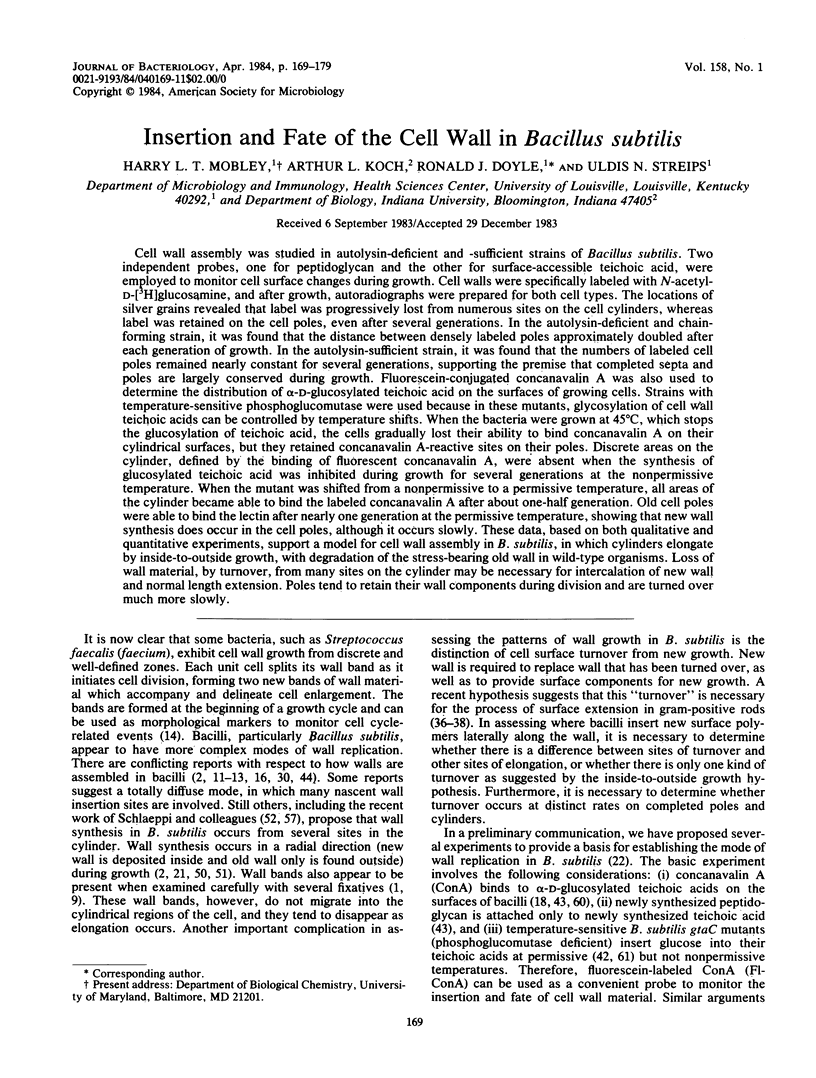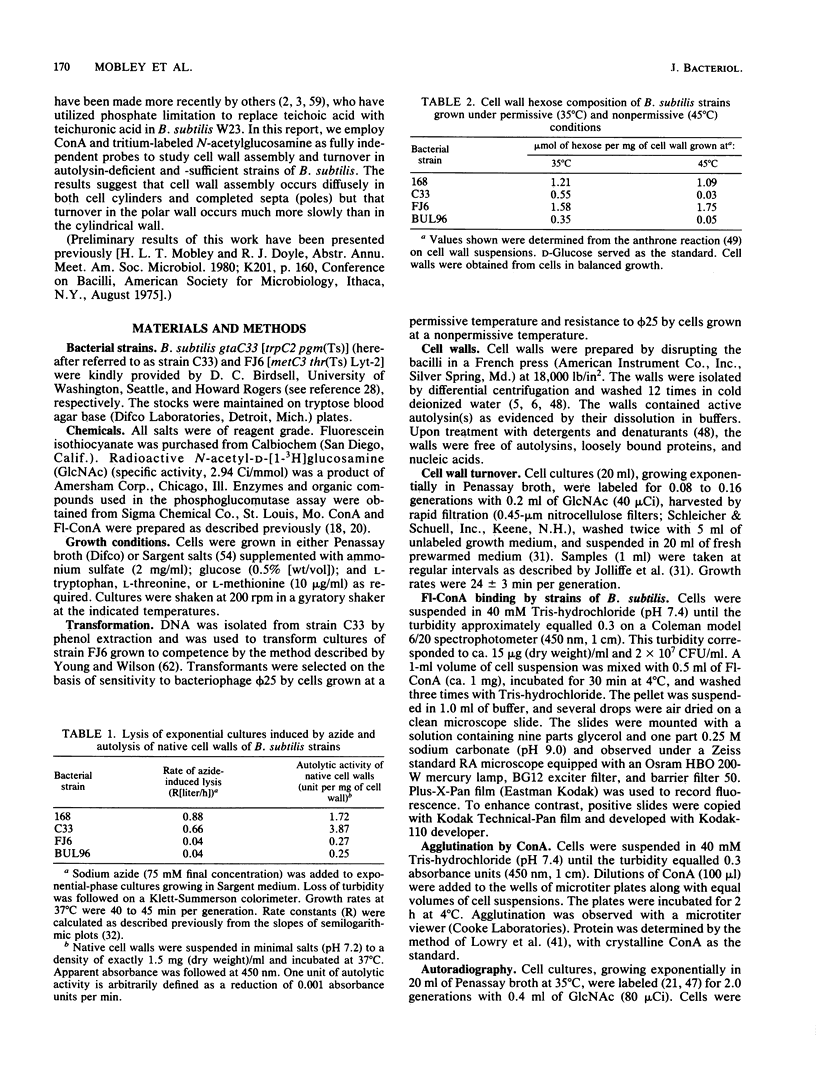Abstract
Cell wall assembly was studied in autolysin-deficient and -sufficient strains of Bacillus subtilis. Two independent probes, one for peptidoglycan and the other for surface-accessible teichoic acid, were employed to monitor cell surface changes during growth. Cell walls were specifically labeled with N-acetyl-D-[3H]glucosamine, and after growth, autoradiographs were prepared for both cell types. The locations of silver grains revealed that label was progressively lost from numerous sites on the cell cylinders, whereas label was retained on the cell poles, even after several generations. In the autolysin-deficient and chain-forming strain, it was found that the distance between densely labeled poles approximately doubled after each generation of growth. In the autolysin-sufficient strain, it was found that the numbers of labeled cell poles remained nearly constant for several generations, supporting the premise that completed septa and poles are largely conserved during growth. Fluorescein-conjugated concanavalin A was also used to determine the distribution of alpha-D-glucosylated teichoic acid on the surfaces of growing cells. Strains with temperature-sensitive phosphoglucomutase were used because in these mutants, glycosylation of cell wall teichoic acids can be controlled by temperature shifts. When the bacteria were grown at 45 degrees C, which stops the glucosylation of teichoic acid, the cells gradually lost their ability to bind concanavalin A on their cylindrical surfaces, but they retained concanavalin A-reactive sites on their poles. Discrete areas on the cylinder, defined by the binding of fluorescent concanavalin A, were absent when the synthesis of glucosylated teichoic acid was inhibited during growth for several generations at the nonpermissive temperature. When the mutant was shifted from a nonpermissive to a permissive temperature, all areas of the cylinder became able to bind the labeled concanavalin A after about one-half generation. Old cell poles were able to bind the lectin after nearly one generation at the permissive temperature, showing that new wall synthesis does occur in the cell poles, although it occurs slowly. These data, based on both qualitative and quantitative experiments, support a model for cell wall assembly in B. subtilis, in which cylinders elongate by inside-to-outside growth, with degradation of the stress-bearing old wall in wild-type organisms. Loss of wall material, by turnover, from many sites on the cylinder may be necessary for intercalation of new wall and normal length extension. Poles tend to retain their wall components during division and are turned over much more slowly.
Full text
PDF










Images in this article
Selected References
These references are in PubMed. This may not be the complete list of references from this article.
- Amako K., Umeda A. Bacterial surfaces as revealed by the high resolution scanning electron microscope. J Gen Microbiol. 1977 Jan;98(1):297–299. doi: 10.1099/00221287-98-1-297. [DOI] [PubMed] [Google Scholar]
- Anderson A. J., Green R. S., Sturman A. J., Archibald A. R. Cell wall assembly in Bacillus subtilis: location of wall material incorporated during pulsed release of phosphate limitation, its accessibility to bacteriophages and concanavalin A, and its susceptibility to turnover. J Bacteriol. 1978 Dec;136(3):886–899. doi: 10.1128/jb.136.3.886-899.1978. [DOI] [PMC free article] [PubMed] [Google Scholar]
- Archibald A. R., Coapes H. E. Bacteriophage SP50 as a marker for cell wall growth in Bacillus subtilis. J Bacteriol. 1976 Mar;125(3):1195–1206. doi: 10.1128/jb.125.3.1195-1206.1976. [DOI] [PMC free article] [PubMed] [Google Scholar]
- Brown W. C., Doyle R. J., Streips U. N. Comparison of various procedures for removing proteins and nucleic acids from cell walls of Bacillus subtilis. Prep Biochem. 1976;6(6):479–488. doi: 10.1080/00327487608069130. [DOI] [PubMed] [Google Scholar]
- Burdett I. D., Higgins M. L. Study of pole assembly in Bacillus subtilis by computer reconstruction of septal growth zones seen in central, longitudinal thin sections of cells. J Bacteriol. 1978 Feb;133(2):959–971. doi: 10.1128/jb.133.2.959-971.1978. [DOI] [PMC free article] [PubMed] [Google Scholar]
- Burdett I. D. Quantitative studies of rod--coccus morphogenesis in a temperature-sensitive rod- mutant of Bacillus subtilis. J Gen Microbiol. 1980 Nov;121(1):93–103. doi: 10.1099/00221287-121-1-93. [DOI] [PubMed] [Google Scholar]
- CHUNG K. L., HAWIRKO R. Z., ISAAC P. K. CELL WALL REPLICATION. I. CELL WALL GROWTH OF BACILLUS CEREUS AND BACILLUS MEGATERIUM. Can J Microbiol. 1964 Feb;10:43–48. doi: 10.1139/m64-007. [DOI] [PubMed] [Google Scholar]
- Chatterjee A. N., Doyle R. J., Streips U. N. A proposed functional role for bacterial N-acetylmuramyl-L-alanine amidases. J Theor Biol. 1977 Oct 7;68(3):385–390. doi: 10.1016/0022-5193(77)90067-4. [DOI] [PubMed] [Google Scholar]
- Chung K. L. Autoradiographic studies of bacterial cell wall replication. I. Cell wall growth of Bacillus cereus in the presence of chloramphenicol. Can J Microbiol. 1967 Apr;13(4):341–350. doi: 10.1139/m67-046. [DOI] [PubMed] [Google Scholar]
- Cole R. M. Symposium on the fine structure and replication of bacteria and their parts. 3. Bacterial cell-wall replication followed by immunofluorescence. Bacteriol Rev. 1965 Sep;29(3):326–344. doi: 10.1128/br.29.3.326-344.1965. [DOI] [PMC free article] [PubMed] [Google Scholar]
- De Boer W. R., Kruyssen F. J., Wouters J. T. Cell wall turnover in batch and chemostat cultures of Bacillus subtilis. J Bacteriol. 1981 Jan;145(1):50–60. doi: 10.1128/jb.145.1.50-60.1981. [DOI] [PMC free article] [PubMed] [Google Scholar]
- Donachie W. D., Begg K. J. Growth of the bacterial cell. Nature. 1970 Sep 19;227(5264):1220–1224. doi: 10.1038/2271220a0. [DOI] [PubMed] [Google Scholar]
- Doyle R. J., Birdsell D. C. Interaction of concanavalin A with the cell wall of Bacillus subtilis. J Bacteriol. 1972 Feb;109(2):652–658. doi: 10.1128/jb.109.2.652-658.1972. [DOI] [PMC free article] [PubMed] [Google Scholar]
- Doyle R. J., McDannel M. L., Helman J. R., Streips U. N. Distribution of teichoic acid in the cell wall of Bacillus subtilis. J Bacteriol. 1975 Apr;122(1):152–158. doi: 10.1128/jb.122.1.152-158.1975. [DOI] [PMC free article] [PubMed] [Google Scholar]
- Doyle R. J. Modification of bacteriophage phi 25 adsorption to Bacillus subtilis by concanavalin A. J Bacteriol. 1973 Jan;113(1):198–202. doi: 10.1128/jb.113.1.198-202.1973. [DOI] [PMC free article] [PubMed] [Google Scholar]
- Doyle R. J., Streips U. N., Imada S., Fan V. S., Brown W. C. Genetic transformation with cell wall-associated deoxyribonucleic acid in Bacillus subtilis. J Bacteriol. 1980 Dec;144(3):957–966. doi: 10.1128/jb.144.3.957-966.1980. [DOI] [PMC free article] [PubMed] [Google Scholar]
- Fan D. P., Beckman B. E., Beckman M. M. Cell wall turnover at the hemispherical caps of Bacillus subtilis. J Bacteriol. 1974 Mar;117(3):1330–1334. doi: 10.1128/jb.117.3.1330-1334.1974. [DOI] [PMC free article] [PubMed] [Google Scholar]
- Fan D. P., Beckman B. E., Gardner-Eckstrom H. L. Mode of cell wall synthesis in gram-positive bacilli. J Bacteriol. 1975 Sep;123(3):1157–1162. doi: 10.1128/jb.123.3.1157-1162.1975. [DOI] [PMC free article] [PubMed] [Google Scholar]
- Fan D. P., Beckman B. E. Structural difference between walls from hemispherical caps and partial septa of Bacillus subtilis. J Bacteriol. 1973 May;114(2):790–797. doi: 10.1128/jb.114.2.790-797.1973. [DOI] [PMC free article] [PubMed] [Google Scholar]
- Fein J. E. Helical growth and macrofiber formation of Bacillus subtilis 168 autolytic enzyme deficient mutants. Can J Microbiol. 1980 Mar;26(3):330–337. doi: 10.1139/m80-054. [DOI] [PubMed] [Google Scholar]
- Fein J. E., Rogers H. J. Autolytic enzyme-deficient mutants of Bacillus subtilis 168. J Bacteriol. 1976 Sep;127(3):1427–1442. doi: 10.1128/jb.127.3.1427-1442.1976. [DOI] [PMC free article] [PubMed] [Google Scholar]
- Fielder F., Glaser L. Assembly of bacterial cell walls. Biochim Biophys Acta. 1973 Dec 28;300(4):467–485. doi: 10.1016/0304-4157(73)90016-6. [DOI] [PubMed] [Google Scholar]
- Hughes R. C., Stokes E. Cell wall growth in Bacillus licheniformis followed by immunofluorescence with mucopeptide-specific antiserum. J Bacteriol. 1971 May;106(2):694–696. doi: 10.1128/jb.106.2.694-696.1971. [DOI] [PMC free article] [PubMed] [Google Scholar]
- Jolliffe L. K., Doyle R. J., Streips U. N. Extracellular proteases increase tolerance of Bacillus subtilis to nafcillin. Antimicrob Agents Chemother. 1982 Jul;22(1):83–89. doi: 10.1128/aac.22.1.83. [DOI] [PMC free article] [PubMed] [Google Scholar]
- Jolliffe L. K., Doyle R. J., Streips U. N. Extracellular proteases modify cell wall turnover in Bacillus subtilis. J Bacteriol. 1980 Mar;141(3):1199–1208. doi: 10.1128/jb.141.3.1199-1208.1980. [DOI] [PMC free article] [PubMed] [Google Scholar]
- Jolliffe L. K., Doyle R. J., Streips U. N. The energized membrane and cellular autolysis in Bacillus subtilis. Cell. 1981 Sep;25(3):753–763. doi: 10.1016/0092-8674(81)90183-5. [DOI] [PubMed] [Google Scholar]
- Koch A. L., Higgins M. L., Doyle R. J. Surface tension-like forces determine bacterial shapes: Streptococcus faecium. J Gen Microbiol. 1981 Mar;123(1):151–161. doi: 10.1099/00221287-123-1-151. [DOI] [PubMed] [Google Scholar]
- Koch A. L., Higgins M. L., Doyle R. J. The role of surface stress in the morphology of microbes. J Gen Microbiol. 1982 May;128(5):927–945. doi: 10.1099/00221287-128-5-927. [DOI] [PubMed] [Google Scholar]
- Koch A. L. On the growth and form of Escherichia coli. J Gen Microbiol. 1982 Nov;128(11):2527–2539. doi: 10.1099/00221287-128-11-2527. [DOI] [PubMed] [Google Scholar]
- Koch A. L. Spatial resolution of autoradiograms of rod-shaped organisms. J Gen Microbiol. 1982 Nov;128(11):2541–2545. doi: 10.1099/00221287-128-11-2541. [DOI] [PubMed] [Google Scholar]
- Koch A. L. The surface stress theory of microbial morphogenesis. Adv Microb Physiol. 1983;24:301–366. doi: 10.1016/s0065-2911(08)60388-4. [DOI] [PubMed] [Google Scholar]
- LOWRY O. H., ROSEBROUGH N. J., FARR A. L., RANDALL R. J. Protein measurement with the Folin phenol reagent. J Biol Chem. 1951 Nov;193(1):265–275. [PubMed] [Google Scholar]
- MOKRASCH L. C. Analysis of hexose phosphates and sugar mixtures with the anthrone reagent. J Biol Chem. 1954 May;208(1):55–59. [PubMed] [Google Scholar]
- Maino V. C., Young F. E. Regulation of glucosylation of teichoic acid. I. Isolation of phosphoglucomutase in Bacillus subtilis 168. J Biol Chem. 1974 Aug 25;249(16):5169–5175. [PubMed] [Google Scholar]
- Mauck J., Chan L., Glaser L., Williamson J. Mode of cell wall growth of Bacillus megaterium. J Bacteriol. 1972 Jan;109(1):373–378. doi: 10.1128/jb.109.1.373-378.1972. [DOI] [PMC free article] [PubMed] [Google Scholar]
- Mauck J., Glaser L. On the mode of in vivo assembly of the cell wall of Bacillus subtilis. J Biol Chem. 1972 Feb 25;247(4):1180–1187. [PubMed] [Google Scholar]
- Mendelson N. H. Bacterial growth and division: genes, structures, forces, and clocks. Microbiol Rev. 1982 Sep;46(3):341–375. doi: 10.1128/mr.46.3.341-375.1982. [DOI] [PMC free article] [PubMed] [Google Scholar]
- Mendelson N. H. Helical Bacillus subtilis macrofibers: morphogenesis of a bacterial multicellular macroorganism. Proc Natl Acad Sci U S A. 1978 May;75(5):2478–2482. doi: 10.1073/pnas.75.5.2478. [DOI] [PMC free article] [PubMed] [Google Scholar]
- Mobley H. L., Doyle R. J., Streips U. N., Langemeier S. O. Transport and incorporation of N-acetyl-D-glucosamine in Bacillus subtilis. J Bacteriol. 1982 Apr;150(1):8–15. doi: 10.1128/jb.150.1.8-15.1982. [DOI] [PMC free article] [PubMed] [Google Scholar]
- Polley H. M., Schlaeppi J. M., Karamata D. Localised insertion of new cell wall in Bacillus subtilis. Nature. 1978 Jul 20;274(5668):264–266. doi: 10.1038/274264a0. [DOI] [PubMed] [Google Scholar]
- Pooley H. M. Layered distribution, according to age, within the cell wall of bacillus subtilis. J Bacteriol. 1976 Mar;125(3):1139–1147. doi: 10.1128/jb.125.3.1139-1147.1976. [DOI] [PMC free article] [PubMed] [Google Scholar]
- Pooley H. M. Turnover and spreading of old wall during surface growth of Bacillus subtilis. J Bacteriol. 1976 Mar;125(3):1127–1138. doi: 10.1128/jb.125.3.1127-1138.1976. [DOI] [PMC free article] [PubMed] [Google Scholar]
- Sandler N., Keynan A. Cell wall synthesis and initiation of deoxyribonucleic acid replication in Bacillus subtilis. J Bacteriol. 1981 Nov;148(2):443–449. doi: 10.1128/jb.148.2.443-449.1981. [DOI] [PMC free article] [PubMed] [Google Scholar]
- Sargent M. G. Control of cell length in Bacillus subtilis. J Bacteriol. 1975 Jul;123(1):7–19. doi: 10.1128/jb.123.1.7-19.1975. [DOI] [PMC free article] [PubMed] [Google Scholar]
- Sargent M. G. Surface extension and the cell cycle in prokaryotes. Adv Microb Physiol. 1978;18:105–176. doi: 10.1016/s0065-2911(08)60416-6. [DOI] [PubMed] [Google Scholar]
- Schlaeppi J. M., Karamata D. Cosegregation of cell wall and DNA in Bacillus subtilis. J Bacteriol. 1982 Dec;152(3):1231–1240. doi: 10.1128/jb.152.3.1231-1240.1982. [DOI] [PMC free article] [PubMed] [Google Scholar]
- Schlaeppi J. M., Pooley H. M., Karamata D. Identification of cell wall subunits in bacillus subtilis and analysis of their segregation during growth. J Bacteriol. 1982 Jan;149(1):329–337. doi: 10.1128/jb.149.1.329-337.1982. [DOI] [PMC free article] [PubMed] [Google Scholar]
- Spizizen J. TRANSFORMATION OF BIOCHEMICALLY DEFICIENT STRAINS OF BACILLUS SUBTILIS BY DEOXYRIBONUCLEATE. Proc Natl Acad Sci U S A. 1958 Oct 15;44(10):1072–1078. doi: 10.1073/pnas.44.10.1072. [DOI] [PMC free article] [PubMed] [Google Scholar]
- de Chastellier C., Hellio R., Ryter A. Study of cell wall growth in Bacillus megaterium by high-resolution autoradiography. J Bacteriol. 1975 Sep;123(3):1184–1196. doi: 10.1128/jb.123.3.1184-1196.1975. [DOI] [PMC free article] [PubMed] [Google Scholar]






